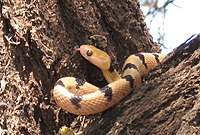Telescopus semiannulatus
| Telescopus semiannulatus | |
|---|---|
 |
|
| T. semiannulatus in an acacia, central Tanzania. The vertical pupils are barely visible due to bright sunlight. | |
| Scientific classification | |
| Kingdom: | Animalia |
| Phylum: | Chordata |
| Subphylum: | Vertebrata |
| Class: | Reptilia |
| Order: | Squamata |
| Suborder: | Serpentes |
| Family: | Colubridae |
| Subfamily: | Colubrinae |
| Genus: | Telescopus |
| Species: | T. semiannulatus |
| Binomial name | |
|
Telescopus semiannulatus A. Smith, 1849 |
|
| Synonyms | |
|
|
Telescopus semiannulatus, commonly known as the African tiger snake, tiger snake, tiger cat snake, or striped cat snake is a species of rear-fanged colubrid snake.
It is found throughout central, eastern, and southern Africa, from Congo to Tanzania to South Africa.
Adults average 60–90 cm (2.0–3.0 ft) in total length, with 17–21 rows of dorsal scales. The tiger snake is one of the more colorful species of snake in the family Colubridae. The upper side is pale orange to salmon pink in color with 24–48 black or dark-brown cross bars or blotches along the back and tail; the underside is pale yellow to orangish pink along the throat, paler along the rest of the body. It has a distinct head and large orange eyes with vertical pupils, and a narrow body with long tail.
The Damara tiger snake, subspecies T. s. polystictus, is found in the highveld of Namibia, has a more mottled appearance and more black bands (up to 75), and may be a separate species.
Telescopus semiannulatus is found in both dry and humid subtropical and tropical habitats, from rocky desert, scrub and savanna, to lowland forest. Largely terrestrial but sometimes arboreal, it shelters under bark and rock or in thatched roofs. It is a nocturnal snake.
Telescopus semiannulatus is rear-fanged and mildly venomous, but not dangerous to humans. Localized swelling might occur. Because Telescopus semiannulatus feeds mostly on lizards, the venom is more effective on other reptiles.
The fangs are grooved, instead of hollow, like most venomous snakes. When Telescopus semiannulatus grabs onto its prey, it holds on and chews venom into the wound, adding constriction to immobilize prey.
Its diet is largely lizards, especially geckos, but also small rodents and fledgeling birds and bats.
...
Wikipedia
